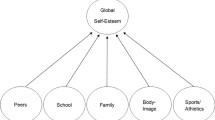Abstract
OBJECTIVES: To investigate differences in the relationship between self-esteem and the initiation of substance use (tobacco, alcohol and marijuana) among male and female secondary school students in British Columbia.
METHODS: The data were collected in the 2010 fall and 2011 spring cycles of the British Columbia Adolescent Substance Use Survey (BASUS). The sample consisted of 1,267 adolescents (57% female) in Grades 8 and 9. Multivariate logistic regression models were used to examine the extent to which self-esteem and gender, and their interaction, influenced the odds of having initiated substance use at baseline and at follow-up 6 months later.
RESULTS: For each one-point increase on the Rosenberg Self-Esteem Scale, there was a reduction in the odds of initiating substance use by up to 9% for tobacco, 3% for alcohol, and 7% for marijuana. The relationships between self-esteem and the initiation of tobacco and alcohol use varied by gender, with boys having slightly less robust associations at the baseline assessment.
CONCLUSION: The results suggest that self-esteem is protective against the initiation of tobacco, alcohol, and marijuana use. Researchers are advised to consider the interactive effects of gender in future longitudinal research examining the relationship between self-esteem and the initiation of substance use, including implications related to the development of substance use prevention programs.
Résumé
OBJECTIFS: Étudier les différences dans la relation entre l’estime de soi et le début de la consommation de substances (tabac, alcool et marijuana) chez les élèves du secondaire en Colombie-Britannique.
MÉTHODE: Nos données ont été recueillies pendant les cycles de l’automne 2010 et du printemps 2011 de l’enquête BASUS (British Columbia Adolescent Substance Use Survey). L’échantillon comprenait 1 267 adolescents (57 % de filles) de 8e et de 9e année. À l’aide de modèles de régression logistique multivariée, nous avons examiné la mesure dans laquelle l’estime de soi et le sexe, et leur interaction, influencent la probabilité d’avoir déjà consommé des substances au début de l’étude et au suivi six mois plus tard.
RÉSULTATS: Pour chaque point d’augmentation sur l’échelle de l’estime de soi de Rosenberg, la probabilité d’avoir commencé à consommer des substances diminuait jusqu’à 9 % pour le tabac, jusqu’à 3 % pour l’alcool et jusqu’à 7 % pour la marijuana. La relation entre l’estime de soi et le début de la consommation de tabac et d’alcool variait selon le sexe, les garçons présentant une association légèrement moins forte à l’évaluation préliminaire.
CONCLUSION: Il semble que l’estime de soi protège contre l’initiation à la consommation de tabac, d’alcool et de marijuana. Nous conseillons aux chercheurs d’examiner les effets interactifs du sexe dans les futures études longitudinales sur le lien entre l’estime de soi et le début de la consommation de substances, y compris les conséquences de l’élaboration de programmes de prévention.
Similar content being viewed by others
References
Marti CN, Stice E, Springer DW. Substance use and abuse trajectories across adolescence: A latent trajectory analysis of a community-recruited sample of girls. J Adolesc 2010;33(3):449–61.
Melchior M, Chastang J-F, Goldberg P, Fombonne E. High prevalence rates of tobacco, alcohol and drug use in adolescents and young adults in France: Results from the GAZEL Youth study. Addict Behav 2008;33(1):122–33.
Veselska Z, Geckova AM, Orosova O, Gajdosova B, van Dijk JP, Reijneveld SA. Self-esteem and resilience: The connection with risky behavior among adolescents. Addict Behav 2009;34(3):287–91.
Young MM, Saewyc E, Boak A, Jahrig J, Anderson B, Doiron-Brun Y, et al. The Cross Canada Report on Student Drug Use. Ottawa, ON: Canadian Centre on Substance Abuse, 2011.
Kokkevi A, Gabhainn SN, Spyropoulou M. Early initiation of cannabis use: A cross-national European perspective. J Adolesc Health 2006;39(5):712–19.
Mann M, Hosman CMH, Schaalma HP, de Vries NK. Self-esteem in a broad-spectrum approach for mental health promotion. Health Educ Res 2004;19(4):357–72.
Wild LG, Flisher AJ, Bhana A, Lombard C. Associations among adolescent risk behaviours and self-esteem in six domains. J Child Psychol Psychiatry 2004;45(8):1454–67.
Zamboanga BL, Schwartz SJ, Jarvis LH, Van Tyne K. Acculturation and substance use among Hispanic early adolescents: Investigating the mediating roles of acculturative stress and self-esteem. J Prim Prev 2009;30(3-4):315–33.
Rosenberg M. Society and the Adolescent Self-image, rev. ed. Middletown, CT, UK: Wesleyan University Press, 1989.
Field A. Discovering Statistics Using SPSS, 3rd ed. Thousand Oaks, CA: Sage, 2009.
Elton-Marshall T, Leatherdale ST, Burkhalter R. Tobacco, alcohol and illicit drug use among Aboriginal youth living off-reserve: Results from the Youth Smoking Survey. CMAJ 2011;183(8):E480–E486.
Hutchinson PJ, Richardson CG, Bottorff JL. Emergent cigarette smoking, correlations with depression and interest in cessation among Aboriginal adolescents in British Columbia. Can J Public Health 2008;99(5):418–22.
Maggs JL, Patrick ME, Feinstein L. Childhood and adolescent predictors of alcohol use and problems in adolescence and adulthood in the National Child Development Study. Addiction 2008;103(Suppl 1):7–22.
Kim IJ, Zane NWS, Hong S. Protective factors against substance use among Asian American youth: A test of the peer cluster theory. J Commun Psychol 2002;30(5):565–84.
Author information
Authors and Affiliations
Corresponding author
Additional information
Funding: This research was supported by funding from the Canadian Institutes of Health Research.
Conflict of Interest: None to declare.
Rights and permissions
About this article
Cite this article
Richardson, C.G., Kwon, JY. & Ratner, P.A. Self-esteem and the Initiation of Substance Use Among Adolescents. Can J Public Health 104, e60–e63 (2013). https://doi.org/10.1007/BF03405656
Received:
Accepted:
Published:
Issue Date:
DOI: https://doi.org/10.1007/BF03405656




